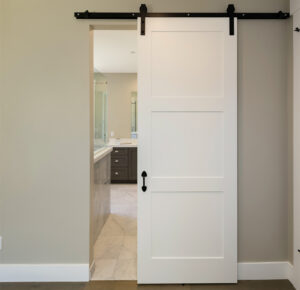Key Takeaways
- Converting a Door: You can turn a regular door into a barn door by removing the current hinges, knobs, and hardware. A fresh coat of paint or stain can help match your existing interior design.
- Hardware Required: Install the necessary barn door hardware, which includes a track, rollers, and mounting board. Ensure you purchase high-quality materials that can withstand the door’s weight.
- Filling Holes: Use wood filler to fill holes left by hinges or doorknobs. After it dries, sand the surface smooth before applying paint or stain.
- Attaching the Track and Rollers: Join the track and rollers with screws and strong wood glue to ensure stability. It’s crucial to secure the track to wall studs or a mounting board for proper support.
- Choosing a Design: Asliding barn door can be a decorative and functional addition. From rustic to modern barn door styles, customize the door to fit your desired aesthetic.
- Purchasing Supplies: You can find all necessary supplies, like sliding door kits and hardware, at home improvement stores or online platforms such as Amazon. It’s advisable to read reviews and product specifications before purchasing.
- Installation Tips: Be mindful of the space required for the door to slide, and consider a guide at the bottom to keep the door in place. Regular maintenance is needed to ensure smooth operation.
Choose Your Barn Door Style
When you decide totransform a regular door into a barn door, the style you choose is crucial to complement your home’s aesthetic. Here are some popular styles you can consider:
- Modern Barn Door: Sleek and minimalistic, these doors often feature clean lines and may come with or without glass panels. Ideal for a contemporary space.
- Shaker Style: Known for its classic and timeless appeal, a shaker barn door has a flat panel design and square edges, which work well in both traditional and modern homes.
- Herringbone Pattern: If you want to make a statement, opt for a door with a herringbone pattern. This dynamic and visually interesting design adds texture and character to any room.
To begin, measure the dimensions of your door to ensure a perfect fit for the hardware. Next, decide on the material and finish that best suit your chosen style. Consider the weight of the door as well, since heavier doors may require sturdier hardware.
Here’s a simple checklist to help you get started:
- Measure your door’s width and height.
- Choose a style that fits your home’s decor.
- Select the material and finish.
- Ensure the door weight is compatible with the hardware.
Remember that the right barn door can serve as more than just a functional element; it can be a central piece of your home’s design.
Choose Your Barn Door Type
To transform a regular door into a barn door, it’s imperative to choose the right barn door type that aligns with your interior style and functional needs. Here is a guide to help you make an informed decision:
- Sliding Barn Door: A popular choice for its space-saving attribute, a sliding barn door glides parallel to the wall and is ideal for areas with limited swing space. Ensure that your door is wide enough to cover the opening with some overlap for privacy.

- Hinged Barn Door: If you prefer the traditional swinging door style with a rustic barn door appeal, you can opt for a hinged barn door. It functions like your conventional door but with barn-style aesthetics. Remember that this style requires clearance for the door to open.
Considerations for Material and Design:
- Solid Wood Door: Choose a solid wood door for its robustness and capability to hold the hardware of a sliding system. A hollow core door may not support the weight of the sliding hardware.
- Door Design: Pick a design that compliments your interior decor. Paneled doors can offer a traditional barn door look, whereas doors with sleek, clean lines provide a modern twist.
Hardware Requirements:
- Sliding Hardware: For a sliding barn door, you must purchase a hardware kit that includes tracks, hangers, and handles. Be prepared to fill any existing knob holes or plan to integrate them into your new design.
- Hinges and Handles: For a hinged barn door, consider the type of hinges and handles that will enhance the barn door’s aesthetics while being functional.
Each barn door type offers a unique set of advantages. Assess your space constraints, design preference, and the physical attributes of your existing interior door to decide on the most suitable barn door transformation. Whether it’s for privacy, aesthetics, or space efficiency, converting to a barn door can be a striking and practical choice for your home.
Before Transforming, Checking Your Original Door

Before embarking on your DIY barn door project, it’s essential to assess your existing door and door frame comprehensively. Here are some key aspects to evaluate:
- Door Dimensions: Ensure your door is wide enough to cover your door opening with an overlap and tall enough to cover the opening’s height. Overlap will provide privacy and reduce gaps when the door is closed.
- Door Structure: Verify that your existing door has a solid frame, not hollow, as a solid structure is required to support the mounting hardware.
- Hardware Removal: Your existing door will need all knobs, latches, or any protruding hardware removed. You can replace them with flat pull handles for smooth sliding action.
- Crafting Materials: Gather the needed materials such as plywood, lumber, wood glue, and trim. You might require a miter saw to cut shaker-style trim or 2x2s to the desired lengths.
- Painting: After any cuts and assembly, use wood filler for gaps, then sand with care. Apply a layer of spray paint primer followed by coats of paint or touch-up paint as needed.
- Assembly: Utilize brad nails, finishing nails, and screws for a secure assembly. If your door requires additional width, add wood or plywood spacers symmetrically on both sides of the door.
Remember that converting any door slab into a barn door can be a budget-friendly option if your current door meets the necessary structural conditions. Protective measures like bumpers and proper rail alignment will ensure your DIY sliding barn door operates smoothly and safely.
Tools and Materials You’ll Need
To convert your existing door into a barn door, you’ll need to gather a variety of tools and materials. Be prepared with the following items:
Tools:
- Miter Saw: Essential for making precise cuts on trim or lumber.
- Brad Nailer (optional): Useful for attaching trim without splitting the wood.
- Circular Saw/Table Saw: Needed if you must cut plywood or lumber to size.
- Drill with Various Bits: For pre-drilling holes and driving screws.
- Level: To ensure your door hangs straight.
- Clamps: Helps to keep materials in place while you work.
- Trim Router (optional): Handy for cleaning up edges or creating grooves.
Materials:
- Plywood/Lumber: Depending on whether you’re adding to your door or constructing new elements.
- Trim: To frame the door and give it a finished barn-door style.
- Spacers: To create a gap between the door and wall for the sliding mechanism.
- Wood Filler: To cover up any holes or imperfections in the wood.
- Wood Glue: To secure any wooden components or trim in place.
- Paint/Touch-Up Paint: For finishing the door in your desired color.
- Screws: A variety of sizes for assembling the door and mounting hardware.
- Spray Paint Primer: If you’re changing the color, start with a primer for a better finish.
Begin by assessing your current door to see if additional lumber or plywood is necessary to achieve the barn door look. Remember, precision is key, so measure twice and cut once. Apply wood filler as needed to smooth out any joinery, followed by a coat of wood glue for a firm hold. Once the structure is sound, use paint or spray paint primer and touch-up paint to complete the aesthetic transformation. Lastly, install with care, ensuring each piece is level and securely fastened with the appropriate screws.
Step-by-step Guidance

Removing the Existing Door
Firstly, unscrew the hinges of your existing door to detach it. Carefully remove the door knob, door latch, and any other mounting hardware.
Preparing the Door
Sand down the door if needed, and consider adding shaker-style trim for a more authentic barn door look using 2x2s and finishing nails.
Assembling the Rail System
Install a sturdy rail above your door frame that can support the weight of your door. This rail will be the track your barn door slides on. Ensure it is level and securely attached to the wall.
Attaching Mounting Hardware
On the top edge of your door, attach the mounting hardware that will connect with the installed rail and allow it to slide.
Creating a Smooth Glide
Installbumpers at both ends of the rail to prevent the door from sliding off. Additionally, use lock mechanisms if privacy is a concern.
Finishing Touches
Finally, paint or stain your door according to your preference, ensuring a budget-friendly transformation that complements your existing decor.
Remember to refer to a detailed tutorial for comprehensive instructions on each step to ensure your DIY project is successful.
Frequently Asked Questions
Transforming a regular door into a barn door involves more than just aesthetics; you need the right components and understanding of the process to create a functional and stylish sliding door for your space.
What are the necessary components in a barn door conversion kit?
To convert a door into a barn door, you’ll require a conversion kit that generally includes rollers, a track, stops, floor guide, and mounting hardware. The precise components might vary based on the kit.
How can I convert a 6-panel door into a barn door?
To convert a 6-panel door into a barn door, you’ll need to install the appropriate track and hardware at the top of the door. Ensure the door is reinforced if needed, since the hardware must support the door’s weight.
Is it possible to repurpose a hollow core door as a barn door?
While you can repurpose a hollow core door as a barn door, it’s essential to reinforce the door where the hardware will be attached to avoid damaging the door due to its less sturdy construction.
What steps are involved in converting a standard door to a sliding barn door?
Converting a standard door to a sliding barn door entails removing your current door and hardware, attaching the necessary barn door hardware, and installing the track to the wall.
Can you retrofit a regular door with barn door hardware for sliding functionality?
Yes, you can retrofit a regular door with barn door hardware for sliding functionality. The key is ensuring the hardware is compatible with your door type and that the door can withstand the weight and movement.
What are the considerations when choosing a door to convert into a sliding door?
When choosing a door to convert, consider the door’s weight, structural integrity, and whether the design complements your interior. Also, check that there is enough wall space for the door to slide open and that the flooring allows for the door’s movement.






